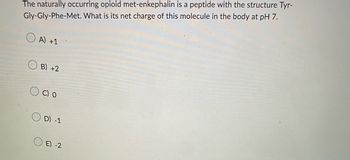
Biochemistry
9th Edition
ISBN: 9781319114671
Author: Lubert Stryer, Jeremy M. Berg, John L. Tymoczko, Gregory J. Gatto Jr.
Publisher: W. H. Freeman
expand_more
expand_more
format_list_bulleted
Question

Transcribed Image Text:The naturally occurring opioid met-enkephalin is a peptide with the structure Tyr-
Gly-Gly-Phe-Met. What is its net charge of this molecule in the body at pH 7.
A) +1
B) +2
C) O
D) -1
E) -2
Expert Solution
This question has been solved!
Explore an expertly crafted, step-by-step solution for a thorough understanding of key concepts.
Step by stepSolved in 3 steps

Knowledge Booster
Similar questions
- For each of the following chemicals, name the general class they belong to, discuss their solubility in water and explain why they are/are not soluble in water: a) CH3(CH2)26COOH b) KCl c) CH3arrow_forwardc) Jean-François is studying a specific protein in a research laboratory. In previous experiments, he observed that this protein seems to function as a receptor protein on the surface of cells that recognizes a specific hormone involved in cell-cell communication. Jean-François prepares his final experiment, but makes a mistake in calculating how much HCl to add to one of his solutions to get the correct pH. He performs the experiment, and much to his surprise, he observes that his protein no longer seems to be recognizing the hormone anymore as he had observed in previous experiments. Propose a hypothesis that briefly explains (2-3 sentences) why the results of Jean-François’ experiment have changed. oportmost likely h beens dy the celyd must irst ir o nm cof the st omce MAnoncalest wanti patient Hewe umourcells Becnuse of falla anan intoindidual.cells. protein d) True or false: A mutation could cause the same change in Jean-François' experimental results as the change in pH described…arrow_forwardThere is parts A-D for the picture provided. A) A peptide has the sequence, Arg-Cys-His-Tyr-Glu-Asn-Lys-Asp. What is the net charge at pH 1? Choices: -5 -4 -3 -2 -1 0 +1 +2 +3 +4 +5 B) A peptide has the sequence Arg-Cys-His-Tyr-Glu-Asn-Lys-Asp. What is the net charge at pH 5? Choices: -5 -4 -3 -2 -1 0 +1 +2 +3 +4 +5 C) Same Peptide sequence, What is the net charge at pH8.5, (N-terminus is pronated) Choices: -5 -4 -3 -2 -1 0 +1 +2 +3 +4 +5 D) A peptide has the sequence, Arg-Cys-His-Tyr-Glu-Asn-Lys-Asp. What is the net charge at pH 13? Choices: -5 -4 -3 -2 -1 0 +1 +2 +3 +4 +5 Thank You!arrow_forward
- "Potassium Bromate (KBr03) is added to flour as a softener that strengthens the texture of bread. It can do this by forming disulfide bonds between two cysteine amino acids in a reaction similar to the chemical equation given below. The function of KBr03 is to remove the 2 electrons needed to form the disulfide bond as shown in the figure below. Each of the cysteine amino acids will be in a protein chain, so the reaction binds the two chains together, giving the dough cohesion. However, potassium bromate is a proven carcinogen and is only allowed in foods in the United States because bakers will add the right amount and correct It has been assumed to meet the temperature and cooking time conditions. " KBRO, + C,H¸NO,SH → KBr + H,O+C,H„N,O,S, Balance the reaction of potassium bromate (KBr03) with the cysteine molecule (C3H6 NO2 SH) by converting it into the reduced step matrix using the additive matrix method. (Kis the symbol of potassium in the question) (Homogeneous linear equation…arrow_forwardCreate an oligopeptide via dehydration synthesis using the following amino acids. O. H Tryptophan (TRP) C-C-N но сн, C-C-N. но Glycine (GLY) H H HNarrow_forwardb) The likelihood of both triglycerides and phospholipids to behave as liquids at a given temperature is affected by their degree of saturation. Explain what saturation is and provide a biochemical explanation for why it affects the likelihood of a lipid to behave as a liquid at a given temperature. 5) a) Proteins have multiple "levels" of structural complexity. Match the type of chemical bond on the left with the level of protein structure that they are specifically involved in maintaining on the right. (Note that more than one letter may apply to each structural level and that each letter may be used more than once or not at all). a. disulphide bonds Tertiary structure b. hydrogen bonds Primary structure c. ionic bonds Quaternary structure d. peptide bonds Secondary structurearrow_forward
arrow_back_ios
arrow_forward_ios
Recommended textbooks for you
 BiochemistryBiochemistryISBN:9781319114671Author:Lubert Stryer, Jeremy M. Berg, John L. Tymoczko, Gregory J. Gatto Jr.Publisher:W. H. Freeman
BiochemistryBiochemistryISBN:9781319114671Author:Lubert Stryer, Jeremy M. Berg, John L. Tymoczko, Gregory J. Gatto Jr.Publisher:W. H. Freeman Lehninger Principles of BiochemistryBiochemistryISBN:9781464126116Author:David L. Nelson, Michael M. CoxPublisher:W. H. Freeman
Lehninger Principles of BiochemistryBiochemistryISBN:9781464126116Author:David L. Nelson, Michael M. CoxPublisher:W. H. Freeman Fundamentals of Biochemistry: Life at the Molecul...BiochemistryISBN:9781118918401Author:Donald Voet, Judith G. Voet, Charlotte W. PrattPublisher:WILEY
Fundamentals of Biochemistry: Life at the Molecul...BiochemistryISBN:9781118918401Author:Donald Voet, Judith G. Voet, Charlotte W. PrattPublisher:WILEY BiochemistryBiochemistryISBN:9781305961135Author:Mary K. Campbell, Shawn O. Farrell, Owen M. McDougalPublisher:Cengage Learning
BiochemistryBiochemistryISBN:9781305961135Author:Mary K. Campbell, Shawn O. Farrell, Owen M. McDougalPublisher:Cengage Learning BiochemistryBiochemistryISBN:9781305577206Author:Reginald H. Garrett, Charles M. GrishamPublisher:Cengage Learning
BiochemistryBiochemistryISBN:9781305577206Author:Reginald H. Garrett, Charles M. GrishamPublisher:Cengage Learning Fundamentals of General, Organic, and Biological ...BiochemistryISBN:9780134015187Author:John E. McMurry, David S. Ballantine, Carl A. Hoeger, Virginia E. PetersonPublisher:PEARSON
Fundamentals of General, Organic, and Biological ...BiochemistryISBN:9780134015187Author:John E. McMurry, David S. Ballantine, Carl A. Hoeger, Virginia E. PetersonPublisher:PEARSON

Biochemistry
Biochemistry
ISBN:9781319114671
Author:Lubert Stryer, Jeremy M. Berg, John L. Tymoczko, Gregory J. Gatto Jr.
Publisher:W. H. Freeman

Lehninger Principles of Biochemistry
Biochemistry
ISBN:9781464126116
Author:David L. Nelson, Michael M. Cox
Publisher:W. H. Freeman

Fundamentals of Biochemistry: Life at the Molecul...
Biochemistry
ISBN:9781118918401
Author:Donald Voet, Judith G. Voet, Charlotte W. Pratt
Publisher:WILEY

Biochemistry
Biochemistry
ISBN:9781305961135
Author:Mary K. Campbell, Shawn O. Farrell, Owen M. McDougal
Publisher:Cengage Learning

Biochemistry
Biochemistry
ISBN:9781305577206
Author:Reginald H. Garrett, Charles M. Grisham
Publisher:Cengage Learning

Fundamentals of General, Organic, and Biological ...
Biochemistry
ISBN:9780134015187
Author:John E. McMurry, David S. Ballantine, Carl A. Hoeger, Virginia E. Peterson
Publisher:PEARSON